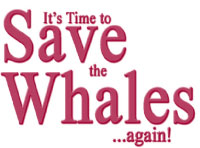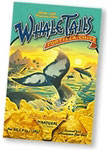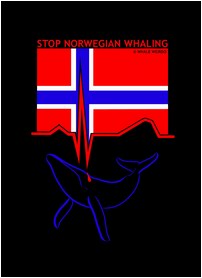HUMPBACK WHALE FACTS
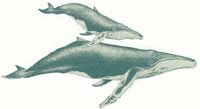
- Average Length: (Adult) 35-50 ft (Newborn) 13-16 ft
- Average Weight: (Adult) 23-30 tons (Birth) 1-2 tons
- Population: 18,000-20,000 (2002 figure)
- Lifespan: estimated to be around 40 years (1998
figure)
- Threats: Caught in fishing nets, human disturbance, and being
tangled in marine pollution
- The flukes (tails) have a distinct pattern on the underside,
much like our fingerprints
- The humpback whale breaches more frequently than other baleen
whales
- The Pacific humpback's pectoral fins are white underneath &
black on top..
- The Atlantic humpback's pectoral fins are white on both sides-
which makes it easier for us to see them
- While in their breeding grounds- the whales do NOT eat!
- Some humpbacks feed in the Southern Ocean and go north to their
reproductive areas!
- Can stay underwater for 30 minutes but often dives for much
shorter periods of time, usually 5 to 10 minutes
- Humpbacks emit high frequency "clicks" reaching 30,000 Hz
- The males produce, in frequencies between 20 and 9,000 Hz,
songs that are the longest and the most varied in all the animal
kingdom, with repeated sequences about 15 minutes long
- When they are in cold waters, the humpback whale eats 2 tons of
fish and planktonic crustaceans a day, in 2 to 4 meals
- Where to Look (Summer): Alaska, Cape Cod, Vancouver
(B.C.), ...
- Where to Look (Winter): Dominican Republic, Turks &
Caicos Islands , Hawaii, Costa Rica, Tonga, ...
|
ORCA FACTS

- Average Length: (Adult) 18-32 ft (Newborn) 7-8 ft
- Average Weight: (Adult) 2.6-9 tons (Birth) 395 lbs
- Nicknames: Killer whale, blackfish, grampus
- Diet: "opportunistic"- the orca is one of the ocean's top
predators (see below)
- Range: All oceans of the world
- Threats: Capture for public display, hunting, pollution
- The largest member of the dolphin family
- There is no known case of a wild orca ever killing a human
- Orcas stay in long-term social groups, or pods, for life (group
size: 3-25)
- Orcas can be reliably seen on tours around Vancouver Island,
off Antarctica, Norway, and Iceland, and occasionally in many other
areas
- Orcas can travel at up to 34 mph (55 km/h)
- There are 2 'genetically' distinct forms of orcas, known as
"transients" and "residents"
- A versatile predator and has one of the most varied diets of
all cetaceans. It is known to eat anything from squid, fish, and
birds to sea turtles, seals, and dolphins; it will even tackle
animals as large as Blue Whales!
- Gestation period is thought to be 12-16 months, with most
calves born between October and March
- Where to Look: One of the most wide-ranging mammals on
earth, though distribution is patchy. Seen more often in cooler
waters than in the tropics and subtropics.
|
|
|
GRAY WHALE FACTS

- Average Length: (Male) 43 ft (Female) 41 ft (Newborn) 15
ft
- Average Weight: (Adult) 26 tons (Birth) 1,500 lbs
- Nicknames: Mussel digger, hard head, devil fish, gray back
- Group size: Generally 1-3; traveling groups can contain up to
16; hundreds can gather in good feeding conditions
- Lifespan: between 30 and 40 years, but may even be up to 60
years
- Gray whales are messy eaters
- Only whale that is known to feed often in the sand and mud
("bottom feeder")... feeding on shellfish, crabs and worms
- Each year, gray whales (only found in the North Pacific ocean)
make the 12,400 mile round trip between Mexico and Alaska
- The cruising speed during migration is about 1 to 3 miles per
hour
- Eastern Pacific gray whales, nearly extinct in the late
nineteenth century, are now thought to number more than 20,000
(1998 figure)
- Young gray whales are often 'friendly', coming to the side of
boats and even lifting them out of the water
- Pregnant females give birth to single calves just before or
soon after arriving at the breeding lagoons; beginning in late
December
- Gestation period is about 13.5 months, with approximately 2
years between pregnancies
- Where to Look: Found in Arctic feeding grounds April to
November, and in Mexican breeding grounds December to April.
Migrates south October to February, and north February to
July.
Searching for Gray whales off the San Diego
coast
|
BLUE WHALE FACTS

- The largest living creature on Earth!
- The record appears to be at least 110 feet long and a weight of
209 tons (It was a female)
- Average Length: (Male) 82 ft (Female) 85 ft (Birth) 19 1/2
ft
- Average Weight: (Adult) 100-120 tons (Newborn) 2.5-4 tons
- Population: low thousands (2002 figure)
- Diet: Krill and Fish
- Range: All oceans of the world
- Lifespan: More than 80 years
- Threats: Loss of food, pollution
- A blue whale drinks 50-150 gallons of milk a day, adding about
8 pounds of weight per hour, or 200 pounds a day
- At about 8 months of age, when the calf is weened, it can
measure close to 50 feet long and weigh about 50,000 pounds
- At sea, blue whales usually feed alone or in pairs, often
widely spaced
- A blue whale's "blow" can reach as high as 30 feet!
- During the feeding period, a blue whale can ingest 4 tons of
krill a day. They feed at the beginning and the end of the night at
a depth of at least 130 feet (40 m).
- Pre-whaling population estimates were over 350,000 blue whales,
but up to 99% of blue whales were killed during whaling
efforts
- Blue whales have no known predators (other than humans during
the whaling years)
- By the 1950s, blue whales were endangered
- Where to Look(Pacific): Channel Islands (near Santa Barbara, CA) during July & August, Also- warm, temperate waters of the Pacific and Indian Oceans. They migrate as far north and south as the Arctic and Antarctic Oceans during the summer.
- Where to Look(Atlantic): They migrate to the Arctic during spring & summer, to waters near Spitsbergen, Davis Strait and Southern Greenland & possibly Baffin Bay. Wintering grounds are not well known. On the eastern side of the Atlantic records exist from the Cape Verde Islands & west Africa & seasonally off Europe and the British Isles. IF you live in Switzerland (Kevin...) - the best bet is West Africa, Iceland or Norway
Distribution & Migration of Blue whales
More facts
|
|
|
FIN WHALE FACTS

- Average Length: (Adult) 59-72 ft (Newborn) 19-21 ft
- Average Weight: (Adult) 30-80 tons (Birth) 2 tons
- Population: 100,000+ (2002 figure)
- Diet: squid, fish, krill or other crustaceans
- Range: Widely distributed... but less common in tropical waters
than temperate waters, and the arctic and Antarctic oceans
- Lifespan: 85 to 90 years
- Threats: Noise from vessels & other underwater noice (which
may mask their social sounds) and Chemical Pollution
- Fin whales have been severely reduced by whaling, which
continued in some places until as recently as the 1980s
 more facts coming soon!
more facts coming soon! 
|
MINKE WHALE FACTS

- Average Length: (Adult) 23-33 ft (Newborn) 8-9 ft
- Average Weight: (Adult) 5-15 tons (Birth) 770 lbs
- Population: 500,000-1 million (2002 figure)
- Diet: Fish, krill or other crustaceans
- Range: All oceans of the world
- Threats: Target of commercial whaling, accidental capture in
fishing gear, pollution
- Lifespan: probably live for 40 - 50 years, but they are
sometimes attacked by killer whales and can be at risk from
collisions with boat traffic
- Minke whales are generally solitary, although they can
sometimes be seen in groups of 2 or 3
- Minke whales are highly inquisitive and are likely to approach
boats, especially younger animals
- The species is still threatened by whaling, which still
continues in the N. Atlantic and Antarctic, with an annual take of
500 - 1000 by countries such as Norway, Japan, & Iceland
 more facts coming soon!
more facts coming soon! 
|
|
|
SPERM WHALE FACTS

- Average Length: (Adult) 36-59 ft (Newborn) 11-14 ft
- Average Weight: (Adult) 20-50 tons (Birth) 1 ton
- Population: Unknown
- Diet: Squid, giant squid, octopus and fish
- Group size: 1-50, hundreds may travel together
- Range: Tropical to sub-polar deep ocean waters worldwide
- Threats: Pollution, noise disturbance, caught in nets
- Sperm whales have the largest heads in the animal kingdom (for
males- up to 35 % of the body length)
- Can dive to depths of 655-985 feet
- Sperm whales can remain submerged for over 2 hours, but typical
dive time is less than 45 minutes
- Sperm whales have unique wrinkled, prunelike skin
- The lifespan of sperm whales are thought to be 75 years or
more
 more facts coming soon!
more facts coming soon! 
|
BOTTLENOSE WHALE FACTS

- Average Length: (Adult) 23-29 ft (Newborn) 9- 11 ft
- Average Weight: (Adult) 5.8-7.5 tons (Birth) unknown
- Population: Unknown
- Diet: Mainly squid; also fish & other invertebrates
 more facts coming soon!
more facts coming soon! 
|
|
|
PILOT WHALE FACTS

- Average Length: 12.5 - 20 ft
- Average Weight: 1.8 - 3.5 tons
- Nicknames: long-finned pilot whale, Blackfish
- Diet:
- Range: cold temperate and subpolar waters of all oceans except the North Pacific
- Population: unknown
- Pilot whales are one of the most commonly mass-stranded whales
- Young whales may breach, but this is rare in adults
- Capable of diving to at least 1,965 ft, but most dives are 100-195 ft
- Where to Look: over the edge of the continental shelf
|
NORTHERN RIGHT WHALE FACTS

- Average Length: (Adult) 36-59 ft (Newborn) 15-20 ft
- Average Weight: (Adult) 30-80 tons (Birth) 1 ton
- Population: Northern ~ 300 (2002 figure)
- Diet: Krill or other crustaceans
- Threats: Fishing gear entanglements and ship strikes
- Right whales were originally named by whalers because they were considered the "right" whales to hunt- full of oil and easy to catch
- Southern Right whales sometimes raise their flukes at right angles to the wind and use them as sails, allowing themselves to be blown along through the water
- Right whales often breach, sometimes up to 10 times or more in a row
- The Northern Right whale is the most endangered whale in the ocean; about 300 in the N.Atlantic and possibly a handful in the N. Pacific
- The Right whale's baleen is ~ 12 inches long!
- Where to Look (Northern): In the feeding grounds- the lower Bay of Fundy, Canada; Browns Bank, off Nova Scotia, Canada; and Cape Cod Bay, USA. Breeding grounds are off Florida and Georgia, USA
The Right Whale Listening Network
|
Sources:
- Carwardine, Mark Whales Dolphins and Porpoises,
DK Publishing, Inc., 1995, 2002
- Carwardine, Mark and Hoyt, Erich and Fordyce, R. Ewan and
Gill, Peter Nature Company Guide: Whales, Dolphins &
Porpoises, Time Life Books, 1998
- Dumont, Jean-Michel and Marion, Remy On the Trail of
Whales, Barron's Educational Series, Inc., 1998
|
WHALE INFO
*Great* Video- Animal
Planet's "Quest: Swimming with Giants"
Call 1-888-404-5969 Order Item# 740688 ($24.90)
"The world's first commercial
whale watching occurred in southern California in early 1955, when
Chuck Chamberlain, a fisherman from San Diego, put out a sign that
said, simply, "See the Whales-- $1."
Source: The Little Guides "Whales Dolphins &
Porpoises"

Please consider joining this Care2 group that I belong to ...
WHALE CALL CAFE
|
WHALE WATCHING TIPS
- Be patient- even if you only see one whale- it is something
you'll never forget!
- If you get seasick often, take medication or get a patch- it
helps!
- Be prepared to get wet- if you have a "nice" camera- bring
something to keep it covered!
- If you use an underwater disposable camera- to get the best
color in your photos, instead of dropping it off at the drug store,
take it to a professional camera shop(which means spending more
money, but it's worth it!)
Don't forget to bring the following
items:
 A camera & plenty of film A camera & plenty of film
 disposable *waterproof* camera disposable *waterproof* camera
 binoculars binoculars
 waterproof jacket waterproof jacket
 sunblock & chapstick sunblock & chapstick
 polarized sunglasses polarized sunglasses
 hat hat
 gloves (depending on the
location/climate) gloves (depending on the
location/climate)
 water & snacks water & snacks
|
|
|
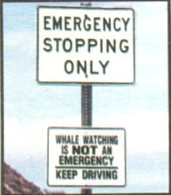












 Sign Our GUESTBOOK
Sign Our GUESTBOOK











